
Pole Position is an arcade racing simulation video game released by Namco in 1982 and licensed to Atari, Inc. for US manufacture and distribution, running on the Namco Pole Position arcade system board. It is considered one of the most important titles from the golden age of arcade video games. Pole Position was an evolution of Namco's earlier arcade racing electro-mechanical games, notably F-1 (1976), whose designer Sho Osugi worked on the development of Pole Position.
Racing games are a video game genre in which the player participates in a racing competition. They may be based on anything from real-world racing leagues to fantastical settings. They are distributed along a spectrum between more realistic racing simulations and more fantastical arcade-style racing games. Kart racing games emerged in the 1990s as a popular sub-genre of the latter. Racing games may also fall under the category of sports video games.

Breakout is an arcade video game developed and published by Atari, Inc. and released on May 13, 1976. It was designed by Steve Wozniak, based on conceptualization from Nolan Bushnell and Steve Bristow who were influenced by the seminal 1972 Atari arcade game Pong. In Breakout, a layer of bricks lines the top third of the screen and the goal is to destroy them all by repeatedly bouncing a ball off a paddle into them. The arcade game was released in Japan by Namco. Breakout was a worldwide commercial success, among the top five highest-grossing arcade video games of 1976 in both the United States and Japan and then among the top three highest-grossing arcade video games of 1977 in the US and Japan. The 1978 Atari VCS port uses color graphics instead of a monochrome screen with colored overlay.

Night Driver is an arcade video game developed by Atari, Inc. and released in the United States in October 1976. It's one of the earliest first-person racing video games and is commonly believed to be one of the first published video games to feature real-time first-person graphics. Night Driver has a black and white display with the hood of the player's car painted on a plastic overlay. The road is rendered as scaled rectangles representing "pylons" that line the edges.

Tomohiro Nishikado is a Japanese video game developer and engineer. He is the creator of the arcade shoot 'em up game Space Invaders, released to the public in 1978 by the Taito of Japan, often credited as the first shoot 'em up and for beginning the golden age of arcade video games. Prior to Space Invaders, he also designed other earlier Taito arcade games, including the shooting electro-mechanical games Sky Fighter (1971) and Sky Fighter II, the sports video game TV Basketball in 1974, the vertical scrolling racing video game Speed Race in 1974, the multi-directional shooter Western Gun in 1975, and the first-person combat flight simulator Interceptor (1975).

Gun Fight, known as Western Gun in Japan and Europe, is a 1975 multidirectional shooter arcade game designed by Tomohiro Nishikado, and released by Taito in Japan and Europe and by Midway in North America. Based around two Old West cowboys armed with revolvers and squaring off in a duel, it was the first video game to depict human-to-human combat. The Midway version was also the first video game to use a microprocessor. The game's concept was adapted from Sega's 1969 arcade electro-mechanical game Gun Fight.
1979 saw many sequels and prequels in video games, such as Space Invaders Part II and Super Speed Race, along with new titles such as Asteroids, Football, Galaxian, Head On, Heiankyo Alien, Monaco GP, Sheriff and Warrior. For the second year in a row, the highest-grossing video game was Taito's arcade game Space Invaders and the best-selling home system was the Atari Video Computer System.
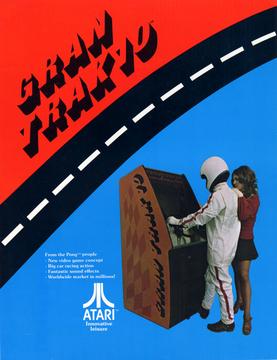
Gran Trak 10 is an arcade driving video game developed by Atari through its subsidiary Cyan Engineering, and released by Atari in May 1974. In the game, a single player drives a car along a race track, viewed from above, avoiding walls of pylons and trying to pass as many checkpoints as possible before time runs out. The game is controlled with a steering wheel, accelerator and brake pedals, and a gear stick, and the car crashes and spins if it hits a pylon.
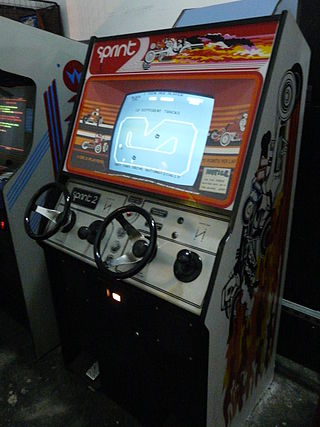
Sprint 2 is a two player overhead-view arcade racing video game released in 1976 by Kee Games, a wholly owned subsidiary of Atari, and distributed by Namco in Japan. While earlier driving games had computer-controlled cars that moved along a "canned predetermined" course, Sprint 2 "introduced the concept of a computer car that had the intelligence to drive itself around the track" in "a semi-intelligent" manner.
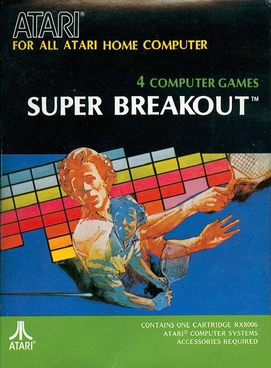
Super Breakout is a sequel to the 1976 video game Breakout released in arcades in September 1978 by Atari, Inc. It was written by Ed Rotberg. The game uses the same mechanics as Breakout, but allows the selection of three distinct game modes via a knob on the cabinet—two of which involve multiple, simultaneous balls in play. Both the original and sequel are in black and white with monitor overlays to add color. It was distributed in Japan by Namco and Esco Trading.
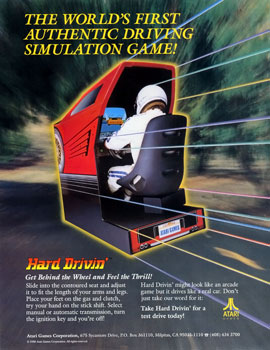
Hard Drivin' is a driving simulation video game developed by Atari Games in 1989. It invites players to test drive a sports car on courses that emphasize stunts and speed. The game features one of the first 3D polygon driving environments via a simulator cabinet with a force feedback steering wheel and a custom rendering architecture.

Sea Wolf is an arcade video game designed by Dave Nutting and released by Midway in 1976. It is a video game update of an electro-mechanical Midway game, Sea Devil, itself based on Sega's 1966 electro-mechanical arcade submarine simulator Periscope. The game was released in Japan by Taito. In Sea Wolf, the player, piloting an unseen submarine, launches torpedoes vertically in an attempt to sink ships moving horizontally across the screen before time runs out. The screen is viewed through a faux periscope mounted on the cabinet.

F-1 is a 1976 electro-mechanical arcade racing game developed and published by Nakamura Manufacturing Company (Namco), and distributed in North America by Atari, Inc. The player uses a steering wheel to control a Formula One racer, which must avoid collision with other vehicles. The game uses a miniature diorama with small, plastic cars to represent the player's car and opponents on a physical, rotating track, while also featuring a projector system and lighting tricks to create the illusion of racing.

Hi-way, also known as Highway, is a 1975 single-player arcade racing game by Atari Inc. Marketed with the slogan “Hi Way — All It Needs Is Wheels,” it was Atari's first game to use a sit-down arcade cabinet.
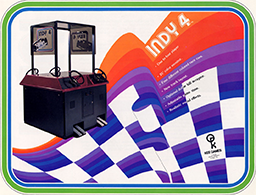
Indy 4 is an arcade driving game by Atari, originally released in 1976. It is a 4-player game that was preceded by its larger 8-player counterpart, Indy 800, in 1975.

Steeplechase is an sports video game by released in arcades 1975 by Atari, Inc. Developed by Atari subsidiary Kee Games, it simulates a steeplechase-style horse race. It was distributed in Japan by Nakamura Seisakusho (Namco) in 1976.

Monaco GP is an arcade racing game released by Sega in November 1979 in Japan, and January 1980 worldwide. An upgraded version, Pro Monaco GP, was released later in 1980. One of the last Sega games to use TTL chips instead of a microprocessor CPU, the game has players race against a clock and pass rival racers while attempting to earn points driving through five areas.

Speed Race is a 1974 arcade racing video game developed and manufactured by Taito and released under the titles Racer and Wheels in North America by distributor Midway Manufacturing in 1975. Designed by Tomohiro Nishikado, the gameplay involves the player using the attached steering wheel to maneuver a car alongside a fast vertical scrolling road. The objective is to score points by driving past other cars without colliding with them; more points are awarded for driving faster. Players must do this under a 90-second time limit, which ends the game when it runs out. The gameplay concepts were adapted from two earlier driving electro-mechanical games: Kasco's Mini Drive (1958) and Taito's Super Road 7 (1970).

Race Drivin' is driving arcade game originally released by Atari Games in 1990. Players must test drive several high-powered sports cars on stunt and speed courses. The game is the sequel to 1989's Hard Drivin' and was part of a new generation of games that featured 3D polygon environments. Unlike most racing games of its time, it attempted to model real world car physics in the simulation of the movement of the player's car. Like Hard Drivin', the game is unique among video games in that it includes a true force feedback steering wheel, an ignition key, a four-speed shifter, and three foot pedals: an accelerator, a brake, and a clutch. Released in August 1990, approximately 1200 units were produced at the time of its release for roughly $9000 each.

LeMans is a single-player race game created by Atari, Inc. in 1976. It was distributed in Japan by Namco. It is the successor to the Gran Trak 10 and Gran Track 20 video games.


















